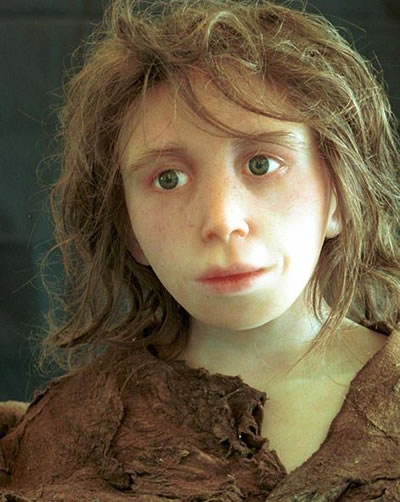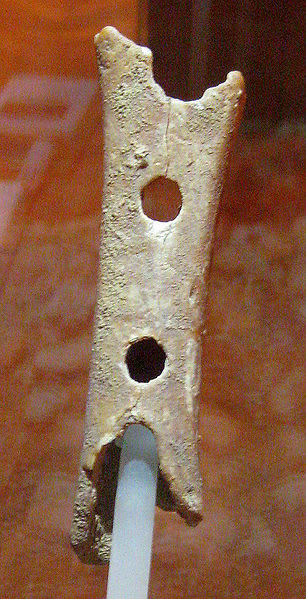The Neanderthals (also spelled Neandertals) were relatives of modern humans (Homo sapiens) who lived on Earth between 130,000 and 30,000 years ago and coexisted with Homo sapiens for thousands of years.
The Neanderthals manufactured and used tools, used fire, hunted, made clothing, cared for their old and infirm, buried their dead, and may have had language, art and music.
They lived in Europe and in western and central Asia.
Although some scientists think that the Neanderthals were of the same species as modern humans - they were a variety of Homo sapiens known as Homo sapiens neanderthalensis, others believe that the Neanderthals belonged to a completely different species: Homo neanderthalensis.
The most recent evidence, which includes the analysis of Neanderthal DNA, seems to indicate that the Neanderthals were a separate species.
Discovery
 The name Neanderthal means "Valley of the Neander". The Neander is a small tributary of the river Düssel, which is near the city of Düsseldorf, Germany.
The name Neanderthal means "Valley of the Neander". The Neander is a small tributary of the river Düssel, which is near the city of Düsseldorf, Germany.
In 1856, workers at a quarry in the Neander Valley found part of a skull and some limb bones. A doctor examined the bones and determined that they came from a human.
However, the skull was very unusual. It was very low, and had almost no forehead. Some scientists thought it was the skull of an ape.
Others thought the strange shape of the skull was the result of a disease - probably rickets.
The British geologist Charles Lyell went to the quarry and verified that the fossils were extremely old.
Thomas Huxley, a British biologist, noticed that while the shape of the skull was different from that of a modern human, the brain would have been larger than a modern human's brain. He concluded that the skull must have come from a primitive human being.
The discovery of these bones took place at about the same time that The Origin of Species, by Charles Darwin, was published. Therefore, it generated a great deal of interest.
Scientists began to reexamine earlier finds and realized that similar remains had been discovered before.
Similarly shaped skulls had been discovered in Belgium in 1829 and in Gibraltar in 1848.
Since then, many Neanderthal bones and artifacts have been found. The fact that the Neanderthals buried their dead greatly increased the chance that their skeletons would be preserved as fossils.
Physical Characteristics
The average Neanderthal had a brain that was larger than a modern human's brain. A Neanderthal's skull had bulges at the sides and the back.
The nose jutted forward and the cheekbones sloped backwards, so that the Neanderthal had no obvious chin.
Male Neanderthals were about five and a half feet tall, and females, about five feet tall.
Neanderthals had rib cages that flared out and no waists.
They were more muscular than modern humans, had large joints, big, bowed limbs and very strong arms and hands.
They could their use hands as skillfully as modern humans could.
Neanderthals had the same gait as Homo sapiens.
Culture
Although the Earth was relatively warm when Neanderthals first appeared on Earth 130,000 years ago, they were alive during the time of the last Ice Age, which began about 70,000 years ago.
They would have had to have been very resourceful to survive in the freezing climate.
The Neanderthals were able to control fire. They used animal skins to make clothes. They created shelters by stretching the animal skins over mammoth bones and tusks.
Tools
The Neanderthals had complex tools. They are known as Mousterian tools, after Le Moustier, a rock shelter in France's Dordogne region.
Their toolkit was much more diverse than that of Home erectus. It included a much wider range of hand axes - which were designed for specific purposes - as well as knives and spears.
Neanderthals fashioned these tools using hammers made of wood, bones and antlers.
Recent research has shown that the tools created by Neanderthals were as efficient as those created by early Homo sapiens.
Hunting
The Neanderthals hunted large animals. They hunted with spears and bolas (throwing weapons consisting of stones tied to a rope). They used stone knives and axes to butcher the animals that they had killed.
Language
Scientists aren't sure whether Neanderthals used language.
There is some evidence that they were physically capable of speech.
In 1983, a hyoid bone from a Neanderthal was found in Israel's Kebara Cave. The hyoid bone links the tongue and the larynx, allowing for a wide range of movement. The Neanderthal hyoid bone was almost identical to those found in Homo sapiens.
The hypoglossal canal, which contains the hypoglossal nerve - the nerve that controls the tongue muscles - is the same size or larger in Neanderthals than in Homo sapiens.
Neanderthals had the same version of gene known as FOXP2 that modern humans have. This gene plays a role in language development. People who don't have this gene have language and speech disorders.
The Neanderthals' lack of a chin may have affected their ability to speak. In modern humans, the mentalis muscle, which is at the tip of the chin, helps us to move our mouths so that we can form words.
Art
Lumps of pigment have been found along with Neanderthal remains.
Some believe that the Neanderthals used these pigments to draw and to dye their own skins.
Jewelry, such as necklaces made from shells that have been dyed and deliberately cut, has also been found at Neanderthal sites.
Music
What may be the earliest known musical instrument in the world, the Divje Babe Flute, was found at a Neanderthal site at Divje Babe archeological park in Slovenia.
The Divje Babe Flute is a bear femur that has been hollowed out. It has at least two holes that appear to have been deliberately bored into it in order to turn it into a musical instrument.
However, some people say that the holes could have been made by a wild animal.
Burials
The Neanderthals were the first members of the genus Homo known to bury their dead.
The first Neanderthal burial site to be discovered was at the cave at La Chapelle-aux-Saints in France.
At Le Moustier in France, a teenage Neanderthal boy was found buried, lying on his side with his head on his arms. Under his head was a pile of flints. There was a stone axe near his hand. Bones from cattle surrounded his body.
A young Neanderthal child was found buried at Teshik-Tash in Uzbekistan. Six pairs of ibex horns were arranged in a ring around his head.
Many Neanderthals were buried in Shanidar in Iraq.
These include a man who was buried 60,000 years ago. He was buried when he was about 30 or 40 years old. Clusters of fossil pollen show that his body was surrounded by flowers, all of which were medicinal herbs. This has made some people think that he may have been a shaman or medicine man.
Care of the Old and Sick
Most of the Neanderthals that were found buried had reached a very old age.
At Shanidar, a Neanderthal man was buried when he was about 40 to 50 years old (probably equivalent to an 80-year-old human of today). He had a fractured left eye socket and would have been partially or totally blind in that eye. He was missing his right hand and the bottom of his right arm, which had been broken in several places. His lower leg and foot were deformed - he would have had a severe limp.
He obtained all of his injuries many years before his death. Other Neanderthals must have taken care of him in order for him to live for as long as he did.
What Happened to the Neanderthals?
The Neanderthals became extinct about 30,000 years ago.
A number of theories attempt to explain why the Neanderthals disappeared.
Some scientists believe that they were killed by modern humans who arrived in Asia and Europe after leaving Africa.
Others say that they died of diseases that Homo sapiens brought with them.
Another theory says that climate change contributed to the Neanderthals' demise. Although the Neanderthals were able to make clothing to keep themselves warm, they may not have adapted their hunting methods to account for changes in plant and animal life.
Some believe that the Neanderthals interbred with modern humans and assimilated with them. However, recent studies of Neanderthal DNA seem to indicate that modern humans do not have any Neanderthal genes.
